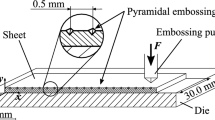Abstract
Magnetostriction is an inherent property of an electrical steel sheet (ESS). Experimental measurements have revealed that the magnetostrictions of Grain-oriented and Non-oriented ESSs are mostly opposite in their directions. Based on this, a novel structure of gap reactor is suggested to reduce the mechanical vibration of the reactor. The new structure follows the conventional manufacturing process, and is built by stacking Grain-oriented and Non-oriented cores alternately while a conventional one is by only Grain-oriented or Non-oriented core. In order to verify the effectiveness of the proposed structure, the electromagnetic vibration, stress and displacement of the reactor are analyzed based on the magneto-elastic coupled analysis. The measured magnetization and magnetostriction data of the ESSs are adopted during the numerical calculation. Prototypes of new and traditional structures with the same design parameters were also built and electromagnetic-induced vibration were measured and analyzed. Both the computational and experimental results showed that the proposed structure made much less electromagnetic vibration than the conventional one. Moreover, the noise level around the reactors were measured and the average noise level around the improved prototype was reduced by 16.7%.














Similar content being viewed by others
References
Swaffield J (1942) The causes and characteristics of transformer noise. J Inst Electr Eng I Gen 89(17):212–224
Moses AJ, Anderson PI, Phophongviwat T (2016) Localized surface vibration and acoustic noise emitted from laboratory-scale transformer cores assembled form grain-oriented electrical steel. IEEE Trans Magn 52(10):7100615
Gao Y, Muramatsu K et al (2010) Design of a reactor driven by inverter power supply to reduce the noise considering electromagnetism and magnetostriction. IEEE Trans Magn 46(6):2179–2182
Shahaj A, Garvey SD (2011) A possible method for magnetostrictive reduction of vibration in large electrical machines. IEEE Trans Magn 47(2):374–385
Delaere K, Heylen W, Hameyer K, Belmans R (2000) Local magnetostriction forces for finite element analysis. IEEE Trans Magn 36(5):3115–3118
Zhu LH, Wang B, Yan RG et al (2016) Electromagnetic vibration of motor core including magnetostriction under different rotation speeds. IEEE Trans Magn 52(3):8102004
Besbes M, Ren Z, Razek A (1996) Finite element analysis of magneto-mechanical coupled phenomena in magnetostrictive materials. IEEE Trans Magn 32(3):1058–1061
Mohammed OA, Calvert TE, Petersen L, McConnell R (2002) Transient modeling of coupled magnetoelastic problems in electric machines. Pow Eng Soc Summer Meet 2002 IEEE Chicago IL 1:281–287
Gros L, Reyne G, Body C, Meunier G (1998) Strong coupling magneto mechanical methods applied to model heavy magnetostrictive actuators. IEEE Trans Magn 34(5):3150–3153
Kitagawa W, Ishihara Y, Todaka T, Nakasaka A (2010) Analysis of structural deformation and vibration of a transformer core by using magnetic property of magnetostriction. Electr Eng Jpn 172(1):19–26
Hilgert T, Vandevelde LJ (2008) Comparison of magnetostriction models for use in calculations of vibrations in magnetic cores. IEEE Trans Magn 44(6):874–877
Yan R, Gao X, Zhu L et al (2016) Research on three-dimensional stress distribution of reactor core. IEEE Trans Appl Supercond 26(4):602004
Acknowledgements
This work was supported by the National Natural Science Foundation of China under Grant 51690181 and 51577131. This research was also supported in part by Basic Science Research Program through the National Research Foundation of Korea (NRF) funded by the Ministry of Education (Grant number 2020R1I1A3A04037180)”
Author information
Authors and Affiliations
Corresponding author
Additional information
Publisher's Note
Springer Nature remains neutral with regard to jurisdictional claims in published maps and institutional affiliations.
Rights and permissions
About this article
Cite this article
Zhu, L., Wang, Q., Sha, R. et al. A New Structure of a Gap-Reactor to Reduce Electromagnetic Vibrations. J. Electr. Eng. Technol. 16, 1437–1443 (2021). https://doi.org/10.1007/s42835-020-00640-1
Received:
Revised:
Accepted:
Published:
Issue Date:
DOI: https://doi.org/10.1007/s42835-020-00640-1




